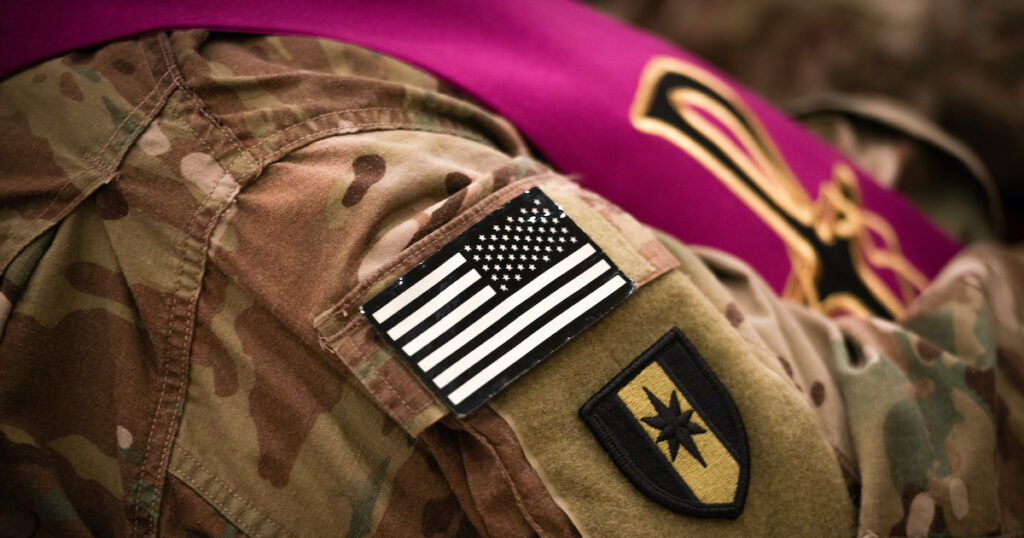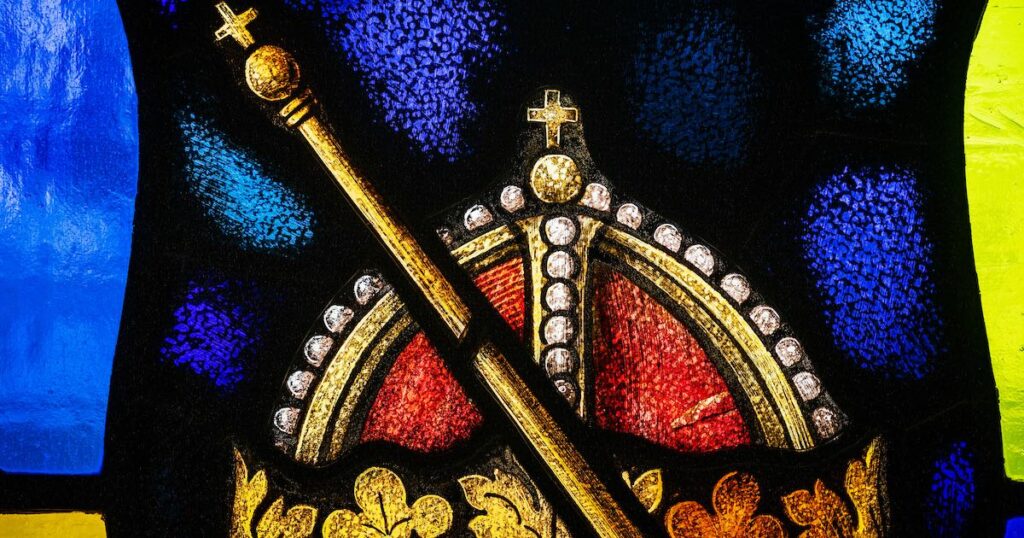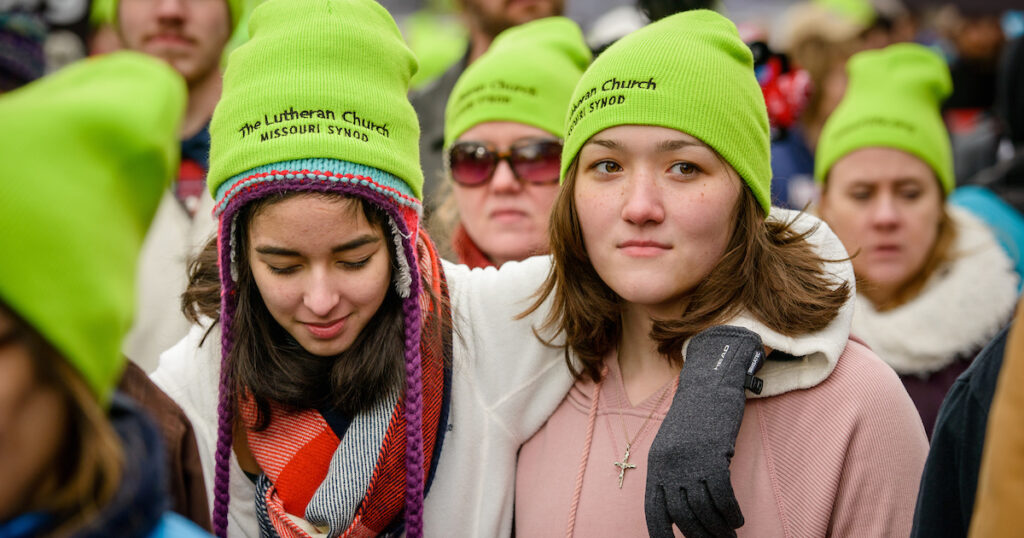I first encountered morning and evening colors at Naval Station Newport in Rhode Island. I had driven across country with four children to celebrate my husband’s graduation from Officer Development School, and we were all spending a precious weekend together before he went straight on to Chaplain School.
After a walking tour of the base, we were on our way back from the commissary with supplies for a bread-and-peanut-butter picnic supper when a short trumpet flourish rang out through the air via loudspeakers mounted on poles in every direction.
Weird, I thought. But also: pretty cool, I guess. Naval life sure is interesting.
Five minutes later, we had just reached the parking lot of the Navy Gateway Lodge when the trumpet sounded again. This time, without a word, Ken dropped his groceries, turned to face the sound, and stood still at attention as the flourish modulated into a stately bugle air, each note echoing through the speakers. Not quite sure what to do, the kids and I hovered awkwardly at his side, wondering whether we should try to mimic his demeanor. As soon the music ended and the last note floated away, he relaxed, picked up the sacks he had dropped and continued his walk.
“What was that all about?” I asked him.
“Evening colors,” he said.
The rite of colors
The military is not a religious institution, but even so, many of its rites and rituals seem better suited to a religious context than a secular one.
Take, for example, morning and evening colors, the set of ceremonies marking the daily raising and lowering of the American flag on military installations. Colors is one of the U.S. military’s more venerable and ubiquitous traditions, though few of those who observe the practice today know much about when or how it began. (According to one Navy source, the practice first appeared in Navy regulations in 1843; an Army source places its origin in the Civil War.) Regardless, everyone who has served in the military or lived on a military base or post knows the protocol to observe.
Other branches (notably the Army) observe colors in their own way, but here is how it’s done in the Navy. At 7:55 in the morning (0755), a short trumpet flourish alerts anyone in hearing distance to get ready. Some people use the opportunity to scurry indoors, where colors need not be observed. I’ve at times picked up my pace on a warm morning run to reach a bit of shade in the distance before the fanfare begins in earnest.
At 0800 hours exactly, the trumpet sounds “Attention,” and the national anthem echoes out over the entire installation. Somewhere nearby, a color guard is raising the flag over the base. Everyone who can see stands and turns to face the colors. Those who can’t see the flag turn their faces in the direction of the music and stand at attention while it plays. Many will put their hands over their hearts. Those in uniform salute. When the music fades, another trumpet flourish known as “Carry On” signals the end of colors and a return to normalcy.
The entire routine repeats itself at sunset, when the flag is lowered, not to “The Star Spangled Banner” but to the solemn song that so captivated me in Rhode Island: “Evening Colors.”
Cars pull over when colors plays, their occupants emerging to stand at attention at the side of the road. Children riding bikes or jumping on trampolines dismount and are still. Adults laughing over wine on a deck set down their glasses and rise in unison as the trumpet calls them to attention.
Twice a day, for sixty seconds, more or less, our small corner of the world stands still, watching and listening.
Civil religion?
Throughout my first year as a Navy wife, I’ve often marveled at how much respect and affection sailors and their families have for traditions such as this. Even the staunchest secularist, the most ardently “spiritual-but-not-religious” service member will honor colors with near religious zeal.
On the flip side, I’ve also sometimes struggled, I’ll confess, to reconcile my own civic duty to honor our nation’s flag with my Christian call to “fear, love and trust in God above all things.” The melody blaring from a speaker mounted high upon a tower reminds me eerily of church bells “chiming and calling” Christians to Sunday worship (LSB 645), or of a muezzin summoning Muslims to daily prayer. Although colors isn’t meant to be a spiritual act of devotion, the striking resemblance it bears to such ancient religious practices is hard to ignore.
“Render to Caesar the things that are Caesar’s, and to God the things that are God’s” (Mark 12:17). It’s easy enough to do when I’m dividing my taxes and my tithes. The receipts tell the story. But what about my respect? My reverence? Those don’t come with itemized receipts. Where do I draw the line between the honor I owe my country and the worship I owe to God alone?
As a Christian, can I — should I — observe colors?
A call to prayer
Perhaps you’ve already guessed my answer to that question. In Christian freedom, honoring Luther’s “Two Kingdoms” theology, I can observe colors, and I do … but with a twist.
As I stand at attention — on my deck, along the jogging trail, by the swings in the playground — my mouth is silent, but my heart is not. While colors rings out around me and the flag is raised and lowered each day, I pray.
In the morning, while “The Star Spangled Banner” is playing, I pray for our nation. I thank God for the blessings and freedoms we enjoy and beg that He would make us worthy of them. I pray mercy for — and relief from — the oppression and injustice that have darkened our shared history. I ask that His Spirit would be poured out upon His people, that they witness boldly and faithfully, so that all within and beyond our borders would hear the blessed Gospel of Jesus Christ, turn from sin and be healed. I pray for wise and virtuous leaders. I pray for unity. I pray for peace at home and abroad. I pray, above all, that God’s will would be done in our land — and in every land.
At evening colors, I pray for our service members. I thank God for their courage and self-sacrifice. I ask His blessing upon their families. I pray for all who are in danger, all who are alone and far from loved ones, all who are anxious, injured, traumatized, caught up in patterns of self-destructive behavior or in the throes of despair. I remember those who have given their lives in service to their country and pray God’s comfort upon all who mourn for them.
This is how I honor the American flag, morning and evening: I stand silently at attention, and I pray for “one nation, indivisible, under God, with liberty and justice for all.”
Will you join me?





As the father of a young sailor stationed at Norfolk, this article brought both joy and tears . May God bless you and your husband in his ministry to our Armed Forces. Thanks be to God for chaplains willing to serve. And thank you for this article.
As a former US Marine and Vietnam veteran, I was also stationed at various military bases in the 1960’s. Morning and evening colors were and are important traditions, and respecting our flag and country are unifying tributes. In my mind, being patriotic doesn’t mean one agrees with everything we have done in our history, and it doesn’t mean we see our country as perfect. It also doesn’t mean we place our country above our reverence to God. We are always Christians first, followers of Jesus, redeemed and saved by grace alone. But we are also blessed having lived in this country, and we desire to make it better. Every time I see our flag and hear the national anthem, I am moved emotionally. My father fought in World War 2, and was wounded. So did my uncles, and one of them limped his entire life as a result of being shot in the leg. We have been blessed. We must thank God, and make America better in every way we can.